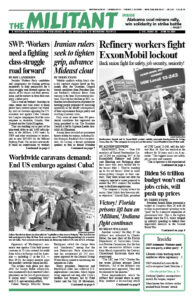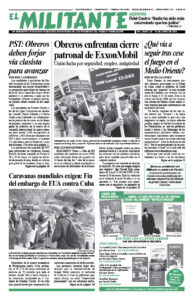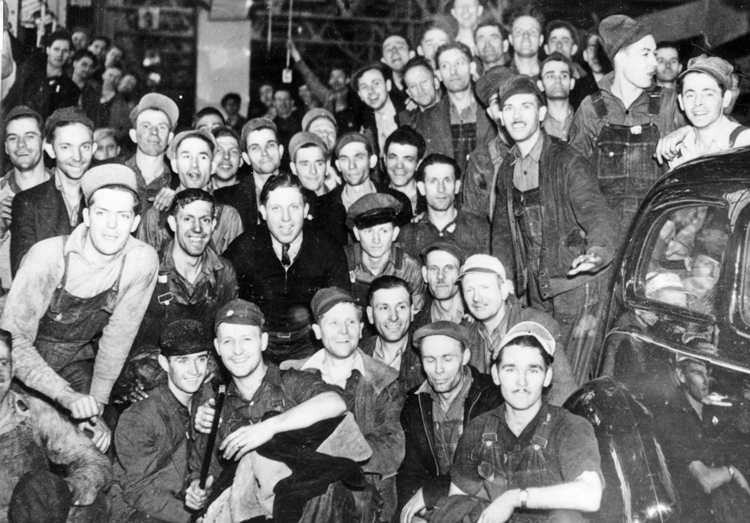One of Pathfinder’s Books of the Month for June is Teamster Politics by Farrell Dobbs. It tells how Teamsters Local 574 members in Minneapolis in 1934 during the Great Depression learned to wield their union power to win strikes. With class-struggle leadership, the Teamsters extended their union throughout the Midwest, helped organize other unions and the unemployed, and strove for political independence. The book is the third in a four-volume series by Dobbs, who emerged from the ranks to become the central organizer of the Teamsters’ 11-state campaign to unionize over-the-road truckers. He served as national secretary of the Socialist Workers Party from 1953 to 1972. The first excerpt is from chapter 3, “Mentality of a Union Bureaucrat,” the second from chapter 9, “Changes in National Trends.” Copyright © 2015 by Pathfinder Press. Reprinted by permission.
If political action is left to the capitalists and their servitors within the labor movement, power generated at the trade-union level can be blunted, and even shattered, through blows from a government under ruling-class control.
Conversely, if the workers enter the political arena as an independent class force, with their own party, they have the strength to wrest state power from the hands of the capitalists. That step could put an end to governmental assaults on trade unions, like the one that struck the Teamsters. A labor government could qualitatively increase the workers’ power, elevating it to a high plane on which all their basic problems as a class could be solved through the necessary transformations in the nation’s social structure.
Even though reformist illusions could be expected to predominate when a national labor party first appeared, the very existence of such a movement would in itself represent an implicitly anticapitalist development. For one thing, the latter characteristic would be a natural consequence of the party’s working-class composition. In addition, organized labor would begin to act in a more unified manner and on a higher plane. The workers would start to generalize their needs in a systematic way and direct their demands in political form at the capitalist class as a whole. That step would not only constitute a meaningful advance beyond pure-and-simple trade unionism; it would also create receptivity to revolutionary policies, which would be oriented toward a working-class struggle for governmental control in order to reorganize society on a socialist basis.
For those reasons, the SWP concluded that questions of program should not be made a decisive criterion for support of a labor party during its formative phase. The main thing at the start was to promote a trade-union break with the capitalist political machine. Therefore, it was decided that the minimum requisites for support of labor candidates on the electoral arena would be that they represent a significant part of the working class and that their campaigns in no way be tied in with capitalist politics. Given the fulfillment of those requirements, labor representatives running for public office would be backed, as against their Democratic and Republican opponents.
In shaping this policy, note was taken of the conditional aspects of such support where matters of program were concerned. Reformist shortcomings in the platforms of labor candidates had to be openly criticized in a fraternal tone, and it was necessary to counterpose a programmatic line based on a class-struggle outlook.
Objectives of this nature could be achieved during the formative period through critical support of labor candidates. But once a labor party was established, new complications had to be expected. These could range from reformist blocs with capitalist politicians to right-wing attacks on revolutionary supporters of the new mass party. Such developments were bound to produce internal polarizations. In that case revolutionaries would back the more progressive tendencies within the party. In doing so, however, the half-way character of the progressives’ political development would be criticized in an effort to help them advance toward a rounded class-struggle outlook.
Close attention would have to be paid to the problem of maintaining trade-union hegemony within the labor party. Otherwise the reformist bureaucrats would gang up with liberal politicians to usurp dictatorial control over the movement, so as to use it in ways that harmed the working class. If that happened, the organization would remain a labor party in composition only. In practice, it would come to act more and more like a capitalist party with respect to policies the bureaucrats sought to carry out.
In combating these possible trends to the right, the revolutionary party would most likely have to enter the electoral arena in its own name and for its own purposes on some occasions. It followed that, once a labor party had become a living reality, need for changes in the policy of critical support would arise. Situations could be expected to develop in which the SWP would run either a partial or full slate of candidates for public office despite the existence of a labor ticket. In that way questions of program could be more effectively stressed, and matters related to the issue of workers’ democracy could be brought out into the open.
On a related point, concerning direct revolutionary activity within a labor party, it was decided that SWP members could join such a movement as individuals wherever the step appeared to be in order. …
During that unfolding process an organized left wing, polarized initially around immediate issues in the class struggle, could grow quite rapidly. Under the impact of experiences in class conflicts, members of that broad left wing could in numerous instances evolve toward understanding and accepting the full socialist program. Finally, in one or another organizational form, determined by the specific circumstances, a mass revolutionary party could be built. Then, and only then, would the insurgent millions have developed a leadership formation capable of guiding them into decisive revolutionary action to abolish the outlived capitalist system.


